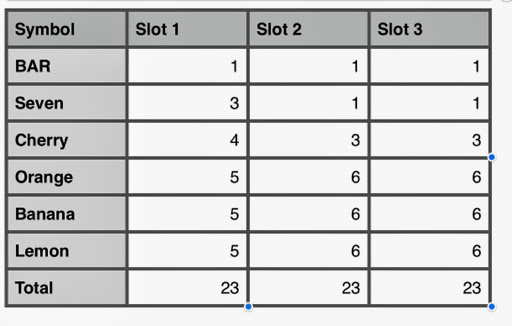The probability of winning on a slot machine is 5%. If a person plays the machine 500 times, find the probability of winning 30 times. Use the normal approximation to the binomial distribution. May 30, 2019 Volatility is an important factor when you have to pick a winning slot machine. This is also referred to as variance and or risk level. It determines the level of risk that is involved while playing for real money. This also determines your winning probability. If volatility is. Mar 15, 2017 The Rules and Maths Behind Slot Machines. MAJOR WINNING ON SKY RIDER 2 SLOT MACHINE - Duration. 30 Minutes of FAST CASH Theme Thursdays Live Play Slot Machine Pokies in.
In a modern slot machine, the odds of hitting a particular symbol or combination of symbols depends on how the virtual reel is set up. As we saw in the last section, each stop on the actual reel may correspond to more than one stop on the virtual reel. Simply put, the odds of hitting a particular image on the actual reel depend on how many virtual stops correspond to the actual stop.

In a typical weighted slot machine, the top jackpot stop (the one with the highest-paying jackpot image) for each reel corresponds to only one virtual stop. This means that the chance of hitting the jackpot image on one reel is 1 in 64. If all of the reels are set up the same way, the chances of hitting the jackpot image on all three reels is 1 in 643, or 262,144. For machines with a bigger jackpot, the virtual reel may have many more stops. This decreases the odds of winning that jackpot considerably.

Advertisement

The losing blank stops above and below the jackpot image may correspond to more virtual stops than other images. Consequently, a player is most likely to hit the blank stops right next to the winning stop. This creates the impression that they 'just missed' the jackpot, which encourages them to keep gambling, even though the proximity of the actual stops is inconsequential.
A machine's program is carefully designed and tested to achieve a certain payback percentage. The payback percentage is the percentage of the money that is put in that is eventually paid out to the player. With a payback percentage of 90, for example, the casino would take about 10 percent of all money put into the slot machine and give away the other 90 percent. With any payback percentage under a 100 (and they're all under 100), the casino wins over time.
In most gambling jurisdictions, the law requires that payback percentages be above a certain level (usually somewhere around 75 percent). The payback percentage in most casino machines is much higher than the minimum -- often in the 90- to 97-percent range. Casinos don't want their machines to be a lot tighter than their competitors' machines or the players will take their business elsewhere.
The odds for a particular slot machine are built into the program on the machine's computer chip. In most cases, the casino cannot change the odds on a machine without replacing this chip. Despite popular opinion, there is no way for the casino to instantly 'tighten up' a machine.
Probability Of Winning A Slot Machines
Machines don't loosen up on their own either. That is, they aren't more likely to pay the longer you play. Since the computer always pulls up new random numbers, you have exactly the same chance of hitting the jackpot every single time you pull the handle. The idea that a machine can be 'ready to pay' is all in the player's head, at least in the standard system.
When you hit the slot machines in a casino, you'll have dozens of gaming options. Machines come with varying numbers of reels, for example, and many have multiple pay lines.
Most machines with multiple pay lines let players choose how many lines to play. For the minimum bet, only the single line running straight across the reels counts. If the player puts more money in, he or she can play the additional horizontal lines above and below the main pay line or the diagonal lines running across the reels.
For machines with multiple bet options, whether they have multiple pay lines or not, players will usually be eligible for the maximum jackpot only when they make the maximum bet. For this reason, gambling experts suggest that players always bet the maximum.
There are several different payout schemes in modern slot machines. A standard flat top or straight slot machine has a set payout amount that never changes. The jackpot payout in a progressive machine, on the other hand, steadily increases as players put more money into it, until somebody wins it all and the jackpot is reset to a starting value. In one common progressive setup, multiple machines are linked together in one computer system. The money put into each machine contributes to the central jackpot. In some giant progressive games, machines are linked up from different casinos all across a city or even a state.
Some slot-machine variations are simply aesthetic. Video slots operate the same way as regular machines, but they have a video image rather than actual rotating reels. When these games first came out, players were very distrustful of them; without the spinning reels, it seemed like the games were rigged. Even though the reels and handles in modern machines are completely irrelevant to the outcome of the game, manufacturers usually include them just to give players the illusion of control.
These are only a few of today's popular slot variations. Game manufacturers continue to develop new sorts of machines with interesting twists on the classic game. A lot of these variations are built around particular themes. There are now slot games based on television shows, poker, craps and horse racing, just to name a few.
To learn more about modern slot machines, including strategies to increase your chances of winning, check out the links below.